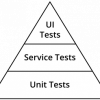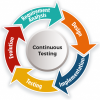test methodologies
 |
5 Steps to Stable Continuous Testing in DevOps Continuous testing minimizes risk and ensures DevOps has the tools to deliver quality, modern code that is ready for the future. To fulfill this, you have to first understand the three types of personas in testing. Then, you'll know how to work with them to progress along the path toward achieving continuous testing. |
|
 |
Key Enablers for Continuous Testing Continuous testing means testing before, during, and after each software change is made. Testers have long advocated for this, but DevOps has made it more popular by pushing for rapid feedback and shifting testing left in the lifecycle. Here are three practices your company should embrace to enable continuous testing. |
|
 |
Change Is Hard, but BDD Is Worth It Behavior-driven development is a methodology change that impacts the whole team, and unfortunately, it’s not as easy as writing scenarios in a specific format. What is the added value of BDD? Why should the team throw their current process out the window and try to incorporate a new methodology? Here are some reasons. |
|
 |
Merging New Codeless Test Automation with Your Existing Code-Based Test Scripts Adopting a codeless solution can be an amazing boost to quality, productivity, and tester career growth, but in most organizations, such test suites will have to be merged into existing code-based test scripts. To succeed, developers, testers, and management all should consider the differences between the two options. |
|
 |
5 Reasons You Should Have More Unit Tests The test pyramid is a valuable visual in agile. In particular, it argues that unit tests should make up the majority of tests, and while agile teams recite this principle, it is often not clear why it is so important. Here are five reasons unit tests should make up the majority of tests written for an application. |
|
 |
Continuous Testing Is Not Automation Many people confuse continuous testing with test automation. That makes sense, because you cannot do continuous testing without automated tests. But it is much more. Continuous testing has a higher-level maturity that could require a totally different way of working—but it also gives a faster path to production. |
|
 |
Writing Tests: Action Abstraction Keywords have become a popular way of writing tests. Hans Buwalda used keywords to devise the Action Based Testing method in which tests are written as sequences of “actions” represented with keywords. However, keywords are just a physical representation of actions, and there are other ways to do this. |
|
 |
An Exploration of Exploratory Testing Exploratory testing is one of the most widely known but poorly understood practices in the software testing community. The term suggests that exploratory testing is a special testing activity, but in reality, all true testing is exploratory in nature. Let's rediscover what exploratory testing should—and shouldn't—mean. |







